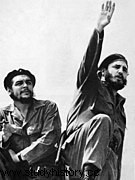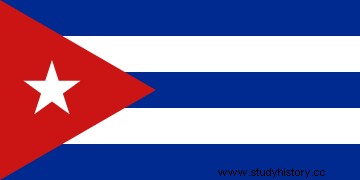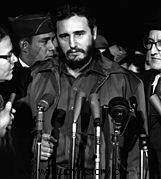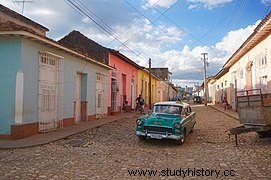Until 1959, Cuba was under the US-funded dictatorship Fulgencio Batista. However, he was overthrown by a group of revolutionaries led by Fidel Castro, in which the Argentine militant Ernesto "Che" Guevara participated. This is the time of the Cold War, and the United States has taken various measures against communism in Cuba, including CIA troops. Fidel Castro's goal was always to liberate Cuba from American economic and social control, but it was unclear whether he, as Guevara clearly did, followed communist ideals. Cuba's socialist regime has survived many measures against it organized by the United States, such as blockades and assassination attempts. It has largely survived because of its commitment to its socialist policies and ideas. This policy has also supported many liberation movements around the world. This article explains the roles of Castro and Guevara in the Cuban revolution, the movement's relations with Washington and Moscow, and the policies of Cuba's communist regime, including its socialist internationalism.
| Planning your Caribbean vacation? Here's a guide!
| Travel guide to Cuba

The Revolution
Fulgencio Batista became dictator of Cuba in 1952 after a coup, and through the 1950s, steady opposition to him grew. Under his rule, class differences increased, with large landowners benefiting from the law. Most of the companies were from the United States, and virtually the entire Cuban economy worked for the country that financed Batista's dictatorship. Conditions for the poor were deteriorating, and Havana, the country's capital, was like a big brothel. Various liberation movements emerged, but perhaps the most important is Fidel Castro's movement. Fidel came from a wealthy family, but he and his brother Raúl had been educated to sympathize with the less fortunate. Raúl Castro was a devout communist, but Fidel remained more ambiguous in ideology in the early years.
Fidel's movement made its first uprising in 1952, the 26th th July. The uprising was suppressed by the Cuban national forces, many members were killed and others, including the Castro brothers, were sentenced to prison - 15 years in the Fidel case. He was released early due to popular pressure on the government, and he immediately fled to Mexico. There he met Ernesto "Che" Guevara, an Argentine communist revolutionary. Ernesto Guevara also came from a privileged family, but had traveled across Latin America with his friend Alberto Granada and seen the effects of poverty and exploitation, much like Marx himself in Europe. Guevara was an avid reader of Steinbeck, Gandhi, Mussolini, and he became obsessed with the image of the martyr sacrificing himself for a greater cause. Guevara was interested in President Jacobo Árbenz of Guatemala, which borders Mexico, who organized a socialist revolution in the country through land reform, and nationalized banana companies from the United States.

After Árbenz was overthrown and the next president began to persecute communists, Guevara became a Marxist, believing that the only hope of his country was a revolution, he joined the Fidel Castro movement in 1956. He was the only non-Cuban in the band, and because he was Argentine, he was nicknamed "Che", a slang term used by Argentines to call attention, as "hello". In December 1956, Castro's band of 82 men left Mexico for Cuba, with a view to resuming the War of Independence. The Mexican government informed Batista about this, and CIA troops had an ambush. Only 16 of Castro's men survived and fled into the Sierra Maestra mountains. Over the next two years, however, they managed to recruit an army of 10,000 men. Some sources say that Che Guevara was obviously a Marxist-Leninist (although anti-Soviet), and Fidel feared that a communist label could be linked to the movement. This label would have cost a lot of world support, something Fidel Castro greatly appreciated. However, other sources suggest that Guevara himself kept his communist inclinations from his comrades, especially as his status grew, because he knew that otherwise they would not have been related to him.
During this time, Fidel's group faced several ambush, and the CIA tried to infiltrate people into the group. Eutimio Guerra was one of the revolution's first collaborators, but he was found to be a spy. Fidel ordered the execution. Although no one ever said who killed Guerra, Guevara's personal journal reveals that it was him. Che describes the scene vividly and describes the gun he used and the thunderstorm that fell at the moment. This was Che's first execution of a comrade, but would not be his last. Under pressure from the CIA and Cuba's national army, the group became intolerable with resistance and was ruthless at the sole suspicion of treason. This was a significant part of the reputation that the revolutionaries had around them in the Sierra Maestra. Trapped between extreme poverty from Batista and the risk of being executed by the revolutionaries, many Cubans fled.
Cuba under Castro
Fidel Castro came in contact with the then president of the Soviet Union, Nikita Sergeyevich Khrushchev, and asked for support. Initially, Khrushchev had not been interested in Cuba, even though he knew about the revolution, but he decided that it would be an advantage for the Soviets to have an ally or headquarters in the Western Hemisphere. Thus, he sent weapons to the Cuban rebels. In 1958, Batista Fidel Castro publicly called him a communist, prompting investigations from Washington DC. However, the investigations concluded that Castro was a nationalist, and therefore not necessarily of international interest. In December of that year, Batista fled Cuba, taking with her one million dollars. In January 1959, Fidel Castro entered Havana and won.
Fidel intended to keep the communist inclinations of many of his men, including Che and Raúl, secret from public opinion. However, there was an intense debate in Washington and Moscow about whether the movement followed this political ideology. Fidel claimed in a public speech that the movement was not Marxist-Leninist, that they would not seize people's land and property, and promised democratic elections within the next 18 months. Despite this, Fidel Castro was appointed Prime Minister of Cuba two months after taking power without election. In the first year of the presidency, he introduced 1,500 new laws, including laws to nationalize agricultural land and a large number of U.S.-owned factories and corporations. Cuba signed an agreement with the Soviet Union to exchange Cuban sugar for Soviet oil and industrial goods. In 1960, when American oil refineries refused to process oil from the Soviet Union, Castro nationalized them as well. It became clearer and clearer that the regime's tendency was Marxist-Leninist.

However, Castro's regime was influenced not only by Marx and Lenin, but also by Latin writers such as José Martí, Antonio Maceo and Simón Bolívar. It is from these authors that the Cuban regime gets its internationalism and anti-imperialism. From the beginning, Fidel's goal was to free the country from American economic control, and Che Guevara had similar visions for the whole of Latin America. Rejection of the United States was precisely the kind of anti-imperialism that Martí advocated. In the first Havana Declaration (Castro 1960), Cuba stated that it stood in solidarity with "all oppressed and exploited nations", and has helped many liberation movements. In fact, Castro had supported many of them across the continent, such as Bogotazo in Colombia in 1948, and Castro's Cuba would continue to support them. The most notable example is Algeria's national liberation movement against the French occupation, which lasted for almost a century.
A paper by Gerber written in 1968 states that conditions for the Cuban people improved significantly after Castro took power. "Life is strict," he admits, especially to those who had been in the upper or middle class when such things still existed, but materially the masses were better off in 1968 than under Batista. Unemployment had fallen sharply, everyone had the right to education, shelter and electricity, and infrastructure such as hospitals and roads had received more attention than in previous years. Mortality from malaria, gastritis and related diseases had fallen sharply in 1966.
But financially, Fidel Castro was not very skilled. He failed to improve gross domestic product, there was a reduction in profit per capita (from $ 450 in 1959 to $ 400 in 1967), and the average Cuban citizen still ate less food per day than recommended by the Food and Agriculture Organization of the United Nations. "The ration book in February 1968, for example, gave each person the right to buy two shirts and two pairs of shoes a year, three kilos of rice," Gerber writes. “... three quarters of a kilo of meat and three grams of coffee a week, and one liter (just over a liter) of fresh milk a day for each child. Bread, eggs and sugar are not rationed. Chicken, although not rationed, has been scarce. The waiting time to buy tires has been as long as a year, and spare parts for cars are reportedly only available through the black market. "Fidel signed the new currency in Cuba with his own name, which was perceived as an insult by many. Major opponents of Leninist communism, Catholic priests are beginning to be seen as enemies of the regime and Fidel expels many from the country, rejecting religion in general.
Castro announced his Marxist-Leninist political position after the invasion of the Bay of Pigs. The CIA, with the support of a local rebel movement, organized an invasion through the Bay of Pigs in southern Cuba in 1961. The invasion failed because Castro knew about it before it happened and could plan ahead - a report commissioned by President Kennedy concluded that someone had leaked the information. which indicates that Allen Dulles, then head of the CIA, was responsible, which may indicate that the CIA wanted the invasion to fail. Fearing that the United States would attack again, Fidel Castro announced that Cuba would join the Soviet Union and publicly declared it a communist regime. In response, the United States has imposed various economic blockades on Cuba, and economic development has been difficult in the country. In 1965, Che Guevara led a group to support a liberation movement in Bolivia. After an ambush by the CIA, he fled to a neighboring village, Higuera said. Some villagers there recognized him and informed the authorities. Che Guevara was captured and killed in 1967.
Cuba today
The current president of Cuba is Raúl Castro, who succeeded his brother after he resigned in 2011. The government is a one-party state and as a video by YouTuber Bald and Bankrupt shows first hand, infrastructure such as houses and roads are very old. The cars are from the Batista period and furniture inside the houses can be 30 to 40 years old, as explained by an article about Biz Evde Yokuz. Bald's video also shows that the country has many national symbols to commemorate and celebrate the revolution. These include pictures of Fidel Castro, posters by Che Guevara, labels that say "Gracias Fidel" (thank you, Fidel), statues of José Martí and signs celebrating 26. th July, the date of the first uprising, which is still the most celebrated date today.
The article on Biz Evde Yokuz, entitled Life in Cuba Today, says that even though wages are very low - a doctor earns $ 30 a month - the government provides each person with housing and a ration that accounts for 40% of the food. They also have universal access to education and medicine, which is almost completely free, except for specialized operations. The constitution also ensures that people have access to music and art, and leisure activities such as concerts are either free or very cheap. On the other hand, life is expensive and people always need a little extra money. For example, many people have made their homes home to tourists because they can earn a doctor's monthly salary in one night. Tourists are charged in CUC, while locals in Pesos (1 CUC =25 Pesos). A night on a homestay can be almost 2 CUC.
| More about today's Cuban culture, read about gastronomy

An analysis of the ideas at stake
The primary goal of the revolutionary movement was to liberate Cuba from the imperial domination of the United States, and only later became Marxist-Leninist through the influence of some of its members such as Che Guevara and Raúl Castro. The movement fought against American companies, which used Cuban resources to bring money to their country without giving Cuba its fair share. As the revolution nationalized corporations and private property, social classes disappeared, worsening conditions for formerly rich people (even though they were better for formerly poor people), and this created resistance that the new regime faced in a similar way to the Batista regime. However, it must be considered that the definitions of "poverty" vary. In communist Cuba, the state provides all its citizens with the most basic necessities. Thus, poverty in communism becomes a categorical concept, as having or not having enough, while in capitalism under Batista it is more of a linear idea, where you can have more and more or less and less.
| More about the history and philosophy of communism, read this
References:
The Truth About Che Guevara Documentary | Biography Documentaries
The Guardian:Che Guevara's legacy is still disputed 50 years after his death
Alpha history:Cuba under Castro
Harris. R (2009). Cuban Internationalism, Che Guevara and the Survival of Cuba's Socialist RegimeGerber (1968). Cuba under Castro.
Cuba They do not want you to see CU
BPS News Times:Fidel Castro, who led Cuba for half a century, dies at age 90
War Secrets:How Fidel Castro Came to Power.
Life in Cuba today Bizevdeyokuz
Question:
The Cuban regime needed to kill the opposition. Could this be related to Hayek's claim to the nature of socialism? If so, why did Batista's dictatorship also kill the opposition?
